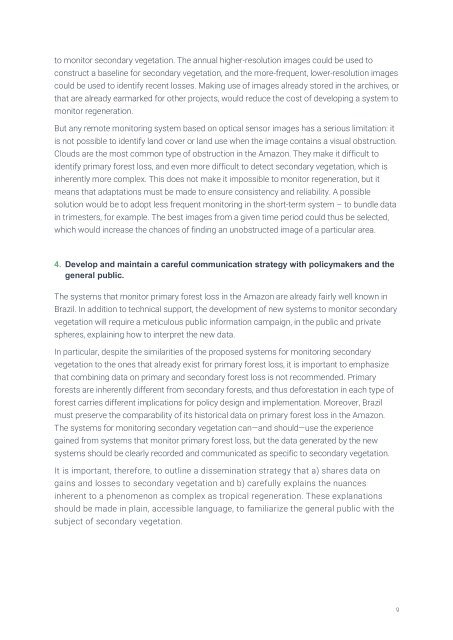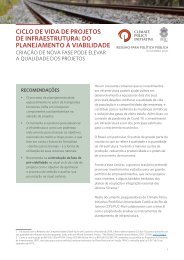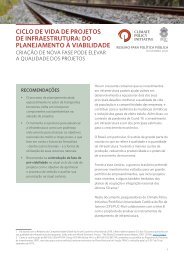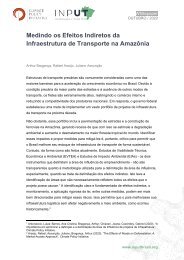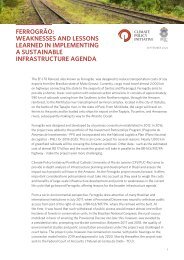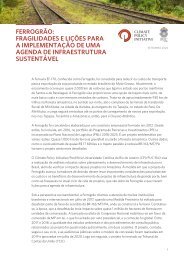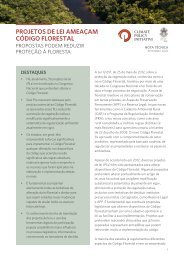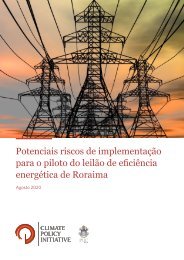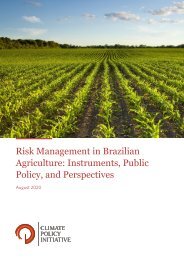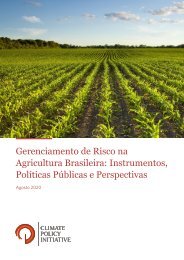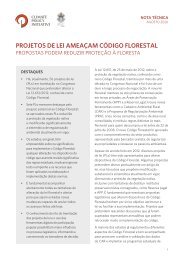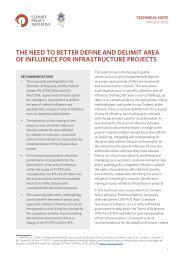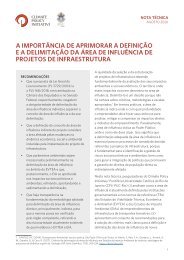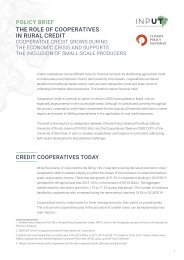Brazil Needs to Monitor its Tropical Regeneration
You also want an ePaper? Increase the reach of your titles
YUMPU automatically turns print PDFs into web optimized ePapers that Google loves.
<strong>to</strong> moni<strong>to</strong>r secondary vegetation. The annual higher-resolution images could be used <strong>to</strong><br />
construct a baseline for secondary vegetation, and the more-frequent, lower-resolution images<br />
could be used <strong>to</strong> identify recent losses. Making use of images already s<strong>to</strong>red in the archives, or<br />
that are already earmarked for other projects, would reduce the cost of developing a system <strong>to</strong><br />
moni<strong>to</strong>r regeneration.<br />
But any remote moni<strong>to</strong>ring system based on optical sensor images has a serious limitation: it<br />
is not possible <strong>to</strong> identify land cover or land use when the image contains a visual obstruction.<br />
Clouds are the most common type of obstruction in the Amazon. They make it difficult <strong>to</strong><br />
identify primary forest loss, and even more difficult <strong>to</strong> detect secondary vegetation, which is<br />
inherently more complex. This does not make it impossible <strong>to</strong> moni<strong>to</strong>r regeneration, but it<br />
means that adaptations must be made <strong>to</strong> ensure consistency and reliability. A possible<br />
solution would be <strong>to</strong> adopt less frequent moni<strong>to</strong>ring in the short-term system – <strong>to</strong> bundle data<br />
in trimesters, for example. The best images from a given time period could thus be selected,<br />
which would increase the chances of finding an unobstructed image of a particular area.<br />
4. Develop and maintain a careful communication strategy with policymakers and the<br />
general public.<br />
The systems that moni<strong>to</strong>r primary forest loss in the Amazon are already fairly well known in<br />
<strong>Brazil</strong>. In addition <strong>to</strong> technical support, the development of new systems <strong>to</strong> moni<strong>to</strong>r secondary<br />
vegetation will require a meticulous public information campaign, in the public and private<br />
spheres, explaining how <strong>to</strong> interpret the new data.<br />
In particular, despite the similarities of the proposed systems for moni<strong>to</strong>ring secondary<br />
vegetation <strong>to</strong> the ones that already exist for primary forest loss, it is important <strong>to</strong> emphasize<br />
that combining data on primary and secondary forest loss is not recommended. Primary<br />
forests are inherently different from secondary forests, and thus deforestation in each type of<br />
forest carries different implications for policy design and implementation. Moreover, <strong>Brazil</strong><br />
must preserve the comparability of <strong>its</strong> his<strong>to</strong>rical data on primary forest loss in the Amazon.<br />
The systems for moni<strong>to</strong>ring secondary vegetation can—and should—use the experience<br />
gained from systems that moni<strong>to</strong>r primary forest loss, but the data generated by the new<br />
systems should be clearly recorded and communicated as specific <strong>to</strong> secondary vegetation.<br />
It is important, therefore, <strong>to</strong> outline a dissemination strategy that a) shares data on<br />
gains and losses <strong>to</strong> secondary vegetation and b) carefully explains the nuances<br />
inherent <strong>to</strong> a phenomenon as complex as tropical regeneration. These explanations<br />
should be made in plain, accessible language, <strong>to</strong> familiarize the general public with the<br />
subject of secondary vegetation.<br />
9


